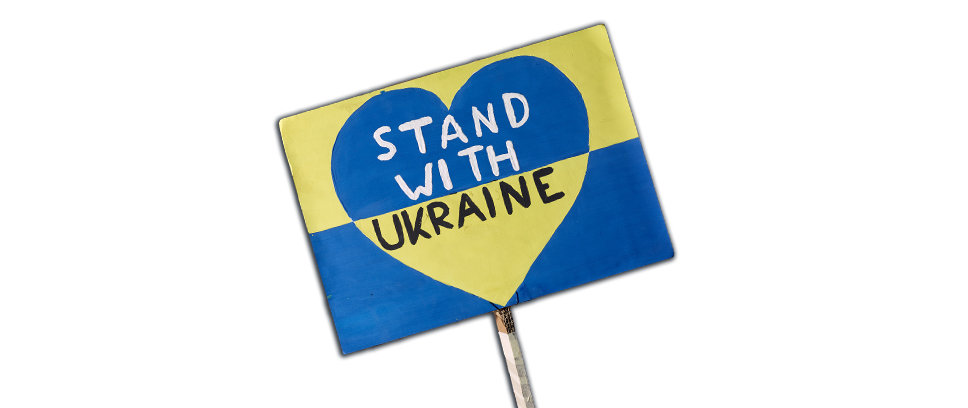
“Stand with Ukraine” – a demonstration sign for Ukraine
Interview with Julia Franke | 24 August 2022
On 24 February 2022, the Russian war of aggression against Ukraine began. Now, exactly six months later, Ukraine celebrates the 31st anniversary of its independence. Against this backdrop we asked Julia Franke, head of the collection Everyday Culture, to tell us about a very new object in the collection of the Deutsches Historisches Museum, a signboard from a peace demonstration.
Why does a museum of history collect current objects?
Of course, it is not always easy to estimate the appreciation and relevance that current objects can and will possibly develop in the future. But when such a caesura as the Russian war of aggression against Ukraine has so great an impact on German society, it is clearly a historical event of intense political resonance that should be reflected in our collection. In particular when it is quickly obvious that the war will have far-reaching ramifications for Germany and the world. The collecting of contemporary objects is, moreover, an opportunity to offer the perspectives of different social groups that are perhaps not yet very strongly represented. And it has the added advantage that it is easier to document the stories and contexts that are connected with the objects’ origins.
What drew your attention to the signboard?
I noticed it during the peace demonstration in Berlin on 13 March 2022, the second major German demonstration against the Russian war of aggression in Ukraine. Although there were numerous signs there in the colours of the Ukrainian flag, this self-painted demonstration signboard was more carefully made. And it combines two central characteristics of the widespread solidarity actions in spring 2022: on the one hand, it uses the colours of the Ukrainian flag, which in spring could often be found in public spaces in Germany. The façades of public buildings shone brightly in the Ukrainian colours, and the Ukrainian flag was hoisted as a sign of solidarity. On the other hand, the sign works with the central, internationally employed English-language slogan “Stand with Ukraine”, which is also often used internationally as a hashtag – encircled by a heart symbol, the symbol of (brotherly) love, close bonding, and solidarity.
How did the sign become part of the museum’s possessions?
I spoke with the man who was carrying the sign, who happened to be the father of a 13-year-old Berlin schoolgirl who had designed and made the sign. Because she had injured her foot, she was not able to participate in the demonstration herself, as planned. For that reason her father carried it through the streets of Berlin in her place.
Is it simply an accident or was it part of a conscious strategy to represent the perspective of a 13-year-old schoolgirl in the collection, a tendentially marginalised perspective, as it were?
In this case, it really is an accident, because the girl who made the sign was not the person who carried it in the demonstration. Of course, museum collections are not neutral storehouses, but rather places of social discussion and negotiation. In addition, they prefer certain topics or aspects of topics and in this way prioritise certain forms of knowledge as well as perspectives. With the help of the concrete stock of objects and the respective prevailing perspectives, it is often possible to draw fairly precise inferences as to who is collecting, or has collected, whose history. Nevertheless, objects that ostensibly offer a hegemonial perspective can naturally be queried in a way counter to that perspective and thus tell entirely different stories than those with which they are usually associated. In this respect, it will be exciting to know what further aspects and topics might be connected in the future with the demonstration signboard from the Berlin peace demonstration.
What is the importance of this object?
First of all, the signboard itself has a role as an actor, because it was displayed publicly. Insofar, it is somehow inherently performative. At the same time, objects from the political protest culture have something ephemeral about them, for demonstrations and protests are normally limited in time. Taking the sign into the political collection of the DHM thus guarantees a long-term availability of the concrete demands, slogans and – in this case – expressions of solidarity with Ukraine in Germany.
The display of the Ukrainian flag or the Ukrainian national colours is a hallmark of the year 2022 and in this way represents something special, because national colours other than those of Germany are so abundantly displayed in the public space. In the case of this sign, the sympathy goes a step further and calls directly for solidarity. The call to stand with the people of Ukraine was and is to be fulfilled in different ways. It is a call for solidarity in multiple regard – both with a view to the war in Ukraine itself and also vis-à-vis the many people who have fled the country, including those who have come to Germany. In this respect, museum collections – as in this concrete case – are something like the megaphone of society and its protests.
|
© DHM/Thomas Bruns |
Julia FrankeJulia Franke is Head of the Collection Everyday Culture: Civil clothing and textiles – Politics – Religion – Emblems at German Historical Museum. |
